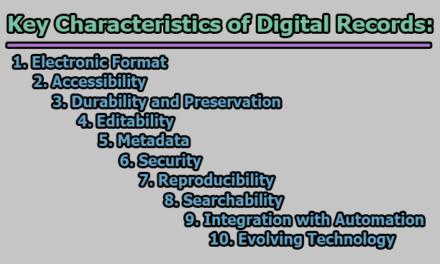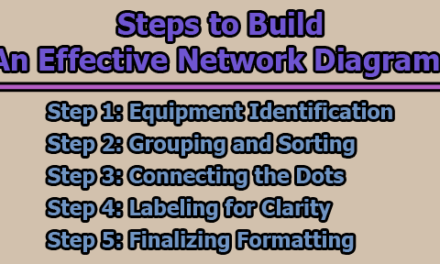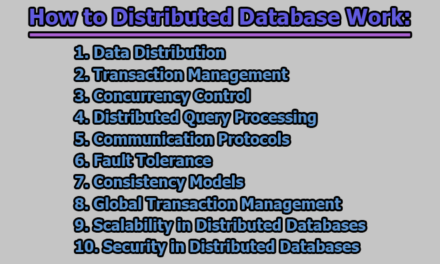Digital Records Management:
In the digital era, organizations are inundated with vast amounts of data and information on a daily basis. Managing this influx of data has become a critical aspect of organizational success and compliance. Digital Records Management (DRM) is a systematic approach to capturing, organizing, securing, and maintaining digital records throughout their lifecycle. This process is essential for ensuring accountability, transparency, and compliance with legal and regulatory requirements. In this article, we will delve into the intricacies of Digital Records Management, covering its significance, key components, challenges, best practices, and emerging trends.
Section 1: The Significance of Digital Records Management:
1.1 Legal and Regulatory Compliance: One of the primary drivers behind the adoption of Digital Records Management is the need for organizations to comply with an ever-growing array of laws and regulations governing data and information. Various industries are subject to stringent compliance requirements, such as the Health Insurance Portability and Accountability Act (HIPAA) in healthcare, the General Data Protection Regulation (GDPR) in Europe, and the Sarbanes-Oxley Act in finance. Effective DRM ensures that organizations can meet these obligations by maintaining accurate, accessible, and secure records.
1.2 Risk Mitigation and Security: As data breaches and cyber threats continue to evolve, organizations face heightened risks related to the confidentiality, integrity, and availability of their records. Digital Records Management plays a crucial role in mitigating these risks by implementing robust security measures. Encryption, access controls, and audit trails are essential components of a secure DRM system, safeguarding sensitive information from unauthorized access and ensuring data integrity.
1.3 Operational Efficiency and Collaboration: Efficient records management is vital for streamlined business operations. Digital records, when managed effectively, facilitate quick and easy retrieval of information, reducing the time and effort spent on searching for relevant data. Moreover, an organized records management system fosters collaboration by enabling teams to access and share information seamlessly. This collaboration is particularly important in the context of remote work and globally distributed teams.
1.4 Cost Reduction and Resource Optimization: An effective Digital Records Management strategy contributes to cost reduction by optimizing resources associated with record creation, storage, and retrieval. By eliminating redundant or obsolete records, organizations can free up storage space, reduce data management costs, and enhance overall resource efficiency. Additionally, automated workflows and processes in DRM systems can minimize the manual labor required for record management tasks.
Section 2: Key Components of Digital Records Management:
2.1 Capture and Ingestion: The first step in DRM is the capture and ingestion of digital records. This involves the creation of records through various channels, such as document creation, email correspondence, and data input into business systems. The challenge lies in ensuring that all relevant records are captured, regardless of their origin, and that they are classified appropriately for future retrieval.
2.2 Classification and Indexing: Proper classification and indexing are fundamental to the organization of digital records. Records should be categorized based on content, context, and relevance to the organization’s business processes. Indexing, often automated through metadata tagging, enables quick and accurate retrieval, ensuring that records are easily located when needed.
2.3 Storage and Preservation: Digital records must be stored in a secure and reliable environment to prevent loss, corruption, or unauthorized access. Cloud storage solutions, on-premises servers, or hybrid approaches are commonly used for this purpose. Preservation strategies involve the use of archival formats, backup systems, and migration plans to ensure the long-term accessibility and integrity of records.
2.4 Access and Retrieval: Ensuring authorized access to digital records is a critical aspect of DRM. Access controls, authentication mechanisms, and role-based permissions are implemented to restrict access to sensitive information. Simultaneously, efficient retrieval mechanisms, such as search functionalities and indexed metadata, enable users to quickly locate and access the records they need.
2.5 Retention and Disposal: Records have a lifecycle, and managing this lifecycle is essential for compliance and resource optimization. Retention policies define how long records should be retained based on legal, regulatory, and business requirements. Disposal processes, including secure deletion or archival, ensure that records are appropriately removed from the system when their retention period expires.
2.6 Audit and Monitoring: Continuous monitoring and auditing of digital records management processes are essential for accountability and compliance. Audit trails capture user activities, changes to records, and access attempts. Regular audits help identify potential security breaches, ensure adherence to policies, and demonstrate compliance during regulatory inspections.
Section 3: Challenges in Digital Records Management:
3.1 Volume and Variety of Data: The sheer volume and diversity of digital data pose a significant challenge for organizations. Managing different types of records, including emails, documents, images, and multimedia files, requires flexible and scalable DRM systems capable of handling a wide range of data formats.
3.2 Data Security and Privacy Concerns: Security and privacy are constant concerns in the digital landscape. Ensuring the confidentiality and integrity of records, protecting against unauthorized access, and complying with data protection regulations require robust security measures. Encryption, access controls, and regular security audits are essential components of an effective DRM strategy.
3.3 Technological Obsolescence: The rapid pace of technological advancement can lead to the obsolescence of DRM systems. Organizations must invest in systems that are adaptable and can evolve with emerging technologies. Migration plans and regular system updates are critical to overcoming the challenges associated with technological changes.
3.4 User Adoption and Training: The success of DRM initiatives depends on user adoption and adherence to established processes. Resistance to change, lack of awareness, and inadequate training can hinder the effective implementation of DRM systems. User-friendly interfaces, comprehensive training programs, and change management strategies are crucial for overcoming these challenges.
3.5 Integration with Business Processes: DRM systems need to seamlessly integrate with existing business processes to ensure a smooth workflow. Poor integration can lead to inefficiencies, data silos, and difficulties in accessing records when needed. Aligning DRM with organizational goals and business processes is essential for maximizing its effectiveness.
Section 4: Best Practices in Digital Records Management:
4.1 Develop a Comprehensive Records Management Policy: The foundation of effective DRM is a well-defined records management policy. This policy should outline the organization’s approach to creating, classifying, storing, and disposing of digital records. It should also address compliance requirements, security measures, and user responsibilities.
4.2 Implement Robust Metadata Management: Metadata plays a crucial role in the classification and retrieval of digital records. Organizations should implement a robust metadata management strategy, including the use of standardized metadata schemas. Consistent and accurate metadata enhance search capabilities and ensure that records are properly classified.
4.3 Automate Where Possible: Automation streamlines records management processes, reduces human error, and enhances efficiency. Implementing automation for routine tasks such as classification, indexing, and retention management can significantly improve the overall effectiveness of DRM systems.
4.4 Ensure Scalability and Flexibility: As data volumes continue to grow, DRM systems must be scalable and flexible. Organizations should choose solutions that can accommodate expanding data sets, new file formats, and changing business requirements. Scalability ensures that the DRM system remains effective as the organization evolves.
4.5 Provide Adequate Training and Support: User adoption is critical for the success of DRM initiatives. Providing comprehensive training programs and ongoing support helps users understand the importance of proper records management and how to use the DRM system effectively. This includes educating users on security practices and compliance requirements.
4.6 Regularly Review and Update Policies: The digital landscape is dynamic, and organizational needs may evolve over time. Regularly reviewing and updating records management policies ensures that they remain aligned with the organization’s goals, industry regulations, and technological advancements. This proactive approach helps address emerging challenges and opportunities.
Section 5: Emerging Trends in Digital Records Management:
5.1 Blockchain Technology for Records Management: Blockchain technology, known for its decentralized and tamper-resistant nature, is gaining traction in records management. It offers enhanced security and transparency, making it suitable for maintaining an immutable and auditable record of transactions and data access.
5.2 Artificial Intelligence and Machine Learning Integration: The integration of Artificial Intelligence (AI) and Machine Learning (ML) in DRM systems enhances automation and decision-making capabilities. These technologies can assist in automatic classification, sentiment analysis, and predictive analytics, making records management more efficient and proactive.
5.3 Cloud-Based Records Management Solutions: Cloud-based DRM solutions are becoming increasingly popular due to their scalability, accessibility, and cost-effectiveness. These solutions offer the flexibility to adapt to changing data volumes and provide remote access, making them well-suited for modern work environments.
5.4 Preservation of Born-Digital Records: With the increasing prevalence of born-digital records, organizations are focusing on strategies for preserving these records in their original digital formats. This includes considerations for file formats, metadata preservation, and the long-term accessibility of digital records.
5.5 Enhanced User Experience and Collaboration Features: User experience is a key factor in the successful implementation of DRM systems. Modern solutions prioritize intuitive interfaces, seamless integration with other tools, and collaborative features to enhance user productivity and encourage widespread adoption.
In conclusion, Digital Records Management is a critical component of information governance in the digital age. Organizations must navigate the complexities of capturing, organizing, securing, and maintaining digital records to ensure compliance, mitigate risks, and optimize operational efficiency. By understanding the significance of DRM, addressing key components, overcoming challenges, adopting best practices, and embracing emerging trends, organizations can establish robust and future-ready records management systems that contribute to their overall success and resilience in a rapidly evolving information landscape.

Assistant Teacher at Zinzira Pir Mohammad Pilot School and College










